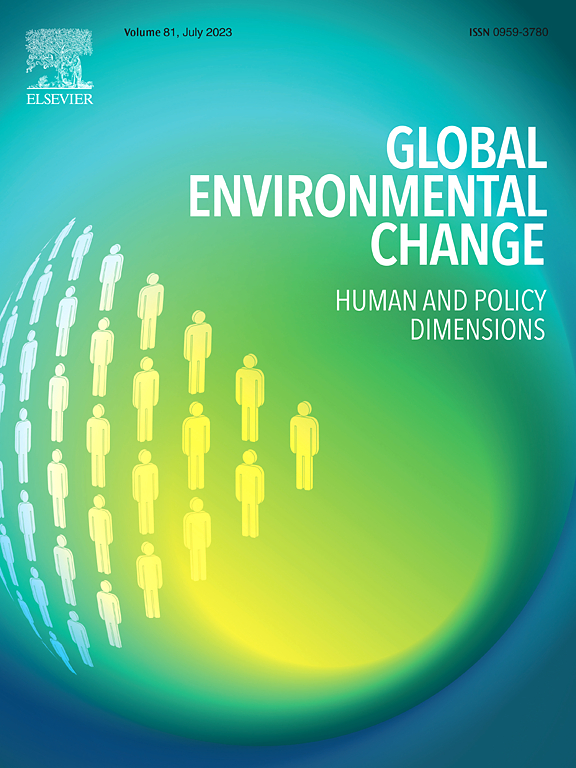理论与行动之间:评估荷兰 51 个气候变化适应案例的变革性特征
IF 9.1
1区 环境科学与生态学
Q1 ENVIRONMENTAL SCIENCES
引用次数: 0
摘要
在全球范围内,研究人员和决策者都在呼吁变革性气候适应(TCA),从根本上改变社会、经济和生态系统的属性,以应对气候风险。然而,对 TCA 进行概念化、评估和实施的尝试非常有限,而且往往导致含义模糊和分散,从而阻碍了转型行动。本研究综合现有文献,提出了一个由六个维度组成的框架,用于评估变革性气候适应行动:(1) 深度;(2) 范围;(3) 规模;(4) 速度;(5) 社会脆弱性;(6) 生态脆弱性。我们将这一框架应用于荷兰的 51 个气候变化适应案例。结果表明,没有一个案例在所有维度上都能获得高分,这表明六个维度之间存在权衡。大多数权衡存在于深度、速度和规模之间,但有时也会延伸到社会和生态脆弱性之间的相互作用。我们发现了多个案例集群,它们显示出不同程度和特征的变革性变化。我们的研究结果进一步呼吁从多维和持续变化的角度看待 TCA,以解决转型理论与转型行动之间的差距。本文提出的框架可以指导未来关于 TCA 驱动因素的实证研究,并帮助治理参与者努力建设更具社会和环境复原力的未来。本文章由计算机程序翻译,如有差异,请以英文原文为准。
Between theory and action: Assessing the transformative character of climate change adaptation in 51 cases in the Netherlands
Globally, researchers and policymakers are calling for transformative climate adaptation (TCA) to fundamentally change the attributes of social, economic, and ecological systems to deal with climate risks. However, attempts to conceptualize, assess, and implement TCA are limited and often result in vague and diffuse meanings, hindering transformative action. This study synthesizes existing literature to introduce a framework consisting of six dimensions for evaluating transformative climate adaptation actions: (1) depth, (2) scope, (3) scale, (4) speed, (5) social vulnerability, and (6) ecological vulnerability. We applied this framework to 51 climate change adaptation cases in the Netherlands. Our results show that no single case scored high on all dimensions, suggesting there are trade-offs between the six dimensions. Most trade-offs exist between depth, speed, and scale; however, they sometimes extend to the interplay between social and ecological vulnerability. We identify multiple clusters of cases that display varying degrees and characteristics of transformative change. Our results strengthen the call for a multidimensional and continuous change perspective of TCA to address the gap between transformative theory and transformative actions. The framework proposed here could guide future empirical research on the drivers of TCA and help governance actors work towards building more socially and environmentally resilient futures.
求助全文
通过发布文献求助,成功后即可免费获取论文全文。
去求助
来源期刊

Global Environmental Change
环境科学-环境科学
CiteScore
18.20
自引率
2.20%
发文量
146
审稿时长
12 months
期刊介绍:
Global Environmental Change is a prestigious international journal that publishes articles of high quality, both theoretically and empirically rigorous. The journal aims to contribute to the understanding of global environmental change from the perspectives of human and policy dimensions. Specifically, it considers global environmental change as the result of processes occurring at the local level, but with wide-ranging impacts on various spatial, temporal, and socio-political scales.
In terms of content, the journal seeks articles with a strong social science component. This includes research that examines the societal drivers and consequences of environmental change, as well as social and policy processes that aim to address these challenges. While the journal covers a broad range of topics, including biodiversity and ecosystem services, climate, coasts, food systems, land use and land cover, oceans, urban areas, and water resources, it also welcomes contributions that investigate the drivers, consequences, and management of other areas affected by environmental change.
Overall, Global Environmental Change encourages research that deepens our understanding of the complex interactions between human activities and the environment, with the goal of informing policy and decision-making.
 求助内容:
求助内容: 应助结果提醒方式:
应助结果提醒方式:


